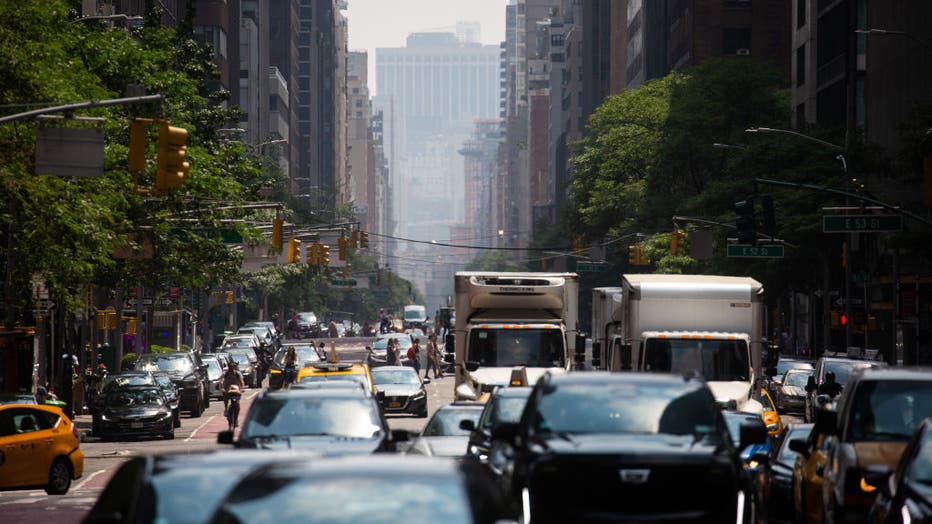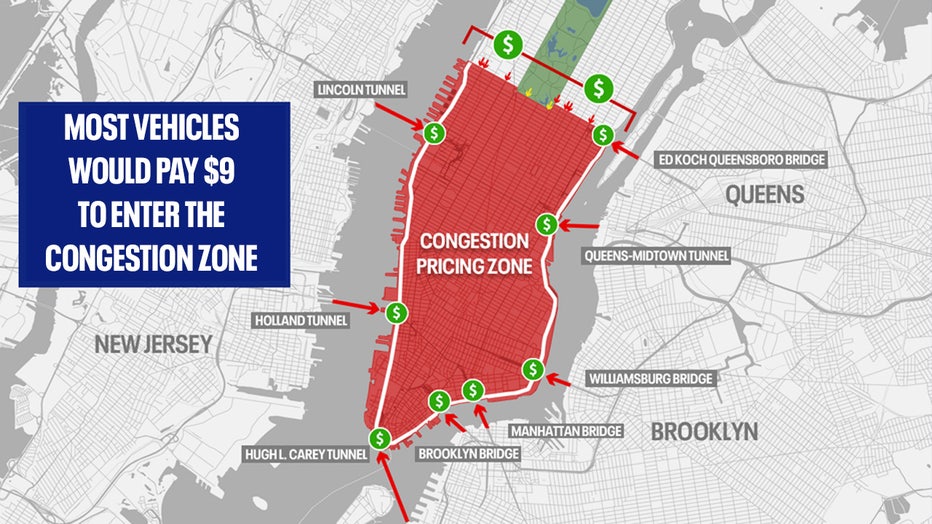How congestion pricing could impact businesses and customers

New NYC congestion pricing plan: Details
Congestion pricing is officially back from the dead, with NYC once again set to become the first major metropolis in the United States to implement such a toll. FOX 5 NY's Hayley Fixler has the details.
NEW YORK - Fears are growing over the toll congestion pricing could take on New York City businesses, especially restaurants and bars caught within the pricing zone.
Nassar Alkuteiny, a business owner in Hell’s Kitchen, says he's concerned over the potential ripple effects.
"It’s gonna hurt a lot of people, a lot of businesses, and I’m gonna be one of them," he told FOX 5 NY's Stephanie Bertini.
One of his main worries is the extra fees distributors may charge to offset the toll.
JUMP TO: Congestion pricing map | Congestion pricing cost
Congestion pricing in Hell's Kitchen
Jr Raksasuwan, owner of Chalong in Hell’s Kitchen, shares similar concerns. "Most of my suppliers drive in from Queens, and they’re going to increase the food price," he said. While he’s committed to keeping menu prices stable, he’s working with his team to develop a strategy for managing the added costs.
Andrew Rigie, executive director of the New York City Hospitality Alliance, says uncertainty is widespread in the industry. "Think of a restaurant or bar—they receive deliveries from various suppliers, and we’re hearing they’ll add congestion surcharges to their checks," he said. "Even if you hire a plumber, they’ll likely pass on the fee, adding to the already high costs for small business owners."

Traffic in the Midtown neighborhood of New York, US, on Saturday, June 17, 2023. New York City's congestion pricing plan for the central business district is expected to get final approval this month. Photographer: Michael Nagle/Bloomberg via Getty I
Beyond operational costs, business owners are also worried about losing customers. Richie Romero, partner at the White Horse Tavern in Greenwich Village, says the toll could deter people from visiting. "If customers can avoid driving into the congestion zone during the week, they might skip it altogether—even on weekends for leisure or entertainment," he explained.
JUMP TO: Congestion pricing map | Congestion pricing cost
The toll also impacts employees, many of whom already commute from outside Manhattan due to high living costs.
With congestion pricing officially moving forward, business owners have no choice but to wait and assess its effects. "We’re worried—very worried," Romero said, reflecting the unease felt across the hospitality industry.
For now, many are left bracing for the added financial strain and hoping for solutions to minimize the toll on their businesses and livelihoods.
What is congestion pricing?
Congestion pricing is aimed at reducing traffic and pollution while encouraging use of public transit. It has long existed in other cities around the globe, including London, Stockholm, Milan and Singapore, but not in the U.S.
Congestion pricing map
Vehicles entering the Manhattan zone, which is local streets and avenues at or below 60 Street – near Central Park – will be charged a toll.

This map shows the proposed zone for New York City congestion pricing.
Drivers on the FDR and West Side Highway passing through the borough will not be charged.
How much does congestion pricing cost?

Hochul answers questions on timing of congestion pricing plan
The program, which would charge drivers a fee for entering Manhattan south of 60th St., aims to ease traffic in central Manhattan, reduce pollution and raise funds for public transit improvements.
Most vehicles would pay $9 to enter the congestion zone. It would come on top of the often-hefty tolls drivers pay to enter Manhattan via some bridges and tunnels.
The toll can still be raised, though Hochul said she does not want to do that for at least three years.
Depending on size, trucks would be charged $14.40 to $21.60 during peak hours.
Rideshare passengers using Uber and Lyft will see an extra $1.50 per-ride surcharge, while taxis will add a $0.75 per-ride fee.
Any passenger vehicles entering the zone through Manhattan tunnels during peak will receive a proposed discount of up to $3.
Drivers will see the highest tolls between 5 a.m. to 9 p.m. on weekdays and 9 a.m. to 9 p.m. on weekends. Tolls will be 75% cheaper outside of peak hours.
How will the MTA benefit?
The money raised through congestion pricing will primarily be used to upgrade the city’s decaying subway system and buses.

